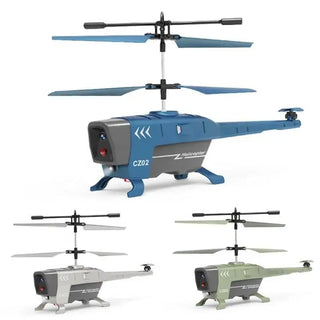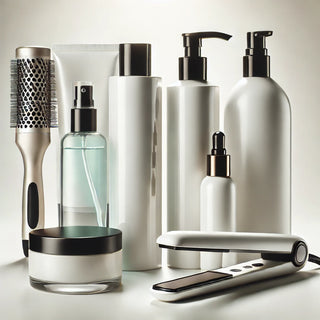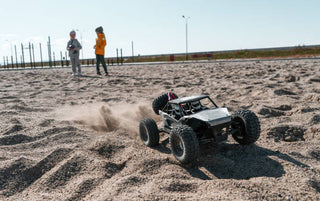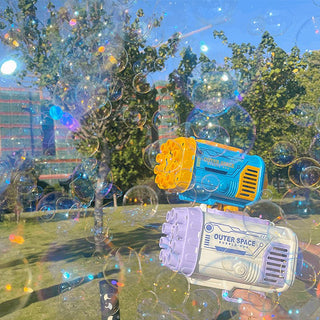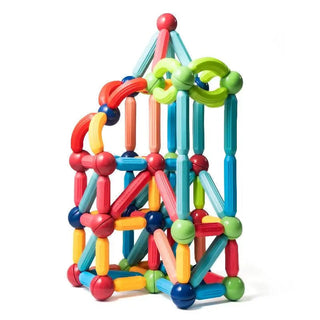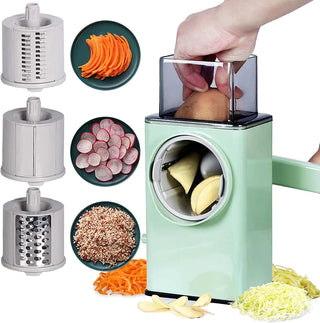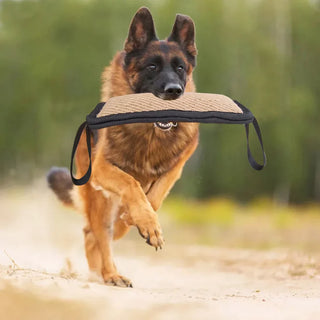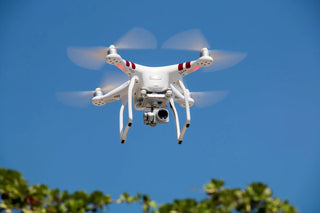Thinking about a career change? Maybe something a bit out there, like flying packages? Amazon drone delivery jobs are really starting to take shape for 2025. It's not just science fiction anymore; the technology is getting closer to being a regular thing. We're talking about drones zipping around, dropping off your online orders. If you're curious about how this works, what it takes to be involved, or just want to know what the future holds for getting stuff delivered, you've come to the right place. Let's look into what these amazon drone delivery jobs might mean for you.
Key Takeaways
- Amazon's Prime Air drone can take off and land vertically and fly horizontally, making it safer and more efficient.
- AI, thermal cameras, and sonar help drones avoid obstacles like people, animals, and wires.
- Drone delivery can cut down on traffic and pollution, offering a greener way to get packages.
- Jobs in drone delivery include operating, fixing, and designing these flying machines.
- The drone delivery market is growing fast, with many companies already making deliveries.
Understanding Amazon Drone Delivery Jobs
Amazon's foray into drone delivery, often referred to as Prime Air, represents a significant shift in how goods might reach consumers. This isn't just about faster shipping; it's about rethinking the entire logistics chain from the ground up, or rather, from the sky down. The company has been quietly working on this technology for years, aiming to make deliveries quicker and more efficient, especially for smaller, lighter items that make up a large portion of online orders. Think about it: most items ordered from Amazon weigh less than five pounds, making them prime candidates for drone transport. The goal is to have drones capable of covering distances of up to 15 miles and completing deliveries in under 30 minutes. This could truly change how we get everyday items, from forgotten groceries to urgent documents.
The Evolution of Amazon's Prime Air
Amazon's Prime Air initiative has been a journey of constant refinement. Over the years, they've tested numerous drone designs, each iteration aiming to improve safety, efficiency, and capability. The latest models, like the "MK27," showcase a hybrid design. This means they can take off and land vertically, much like a helicopter, but then transition to horizontal flight, similar to an airplane, for more efficient travel. This design offers greater stability and maneuverability, operating on six axes of movement compared to older four-axis systems. It's a big step from the early prototypes, showing a clear progression towards a more robust and practical delivery system.
Key Innovations in Drone Technology
The technology powering these drones is quite advanced. They utilize a combination of sensors like thermal cameras, depth cameras, and sonar to detect obstacles in real-time. This allows the drones to operate autonomously, identifying and avoiding potential hazards such as people, animals, or even clotheslines. The onboard computers are programmed to make smart decisions, adapting to environmental changes during flight. Safety is a major focus, with rotor covers designed not only to protect the spinning blades but also to function as wings during sustained flight, contributing to a quieter and more aerodynamic profile.
The Future of Aerial Logistics
While the exact timeline for widespread public use remains uncertain, Amazon is pushing forward. The company envisions a future where drone delivery is a common sight, integrated into the existing Prime membership. This vision extends beyond mere convenience; it touches on creating a more sustainable and accessible delivery network. Imagine receiving essential supplies in remote areas or during emergencies, delivered by drone when traditional routes are impassable. The potential impact on commerce is vast, promising increased efficiency and a reduced environmental footprint compared to traditional delivery methods. It's a complex undertaking, involving regulatory approvals and public acceptance, but the groundwork is being laid for a significant change in how we receive goods.
The Technology Behind the Deliveries
So, how exactly do these flying machines get your stuff from point A to point B? It's pretty wild when you think about it. We're talking about some seriously advanced tech making these deliveries happen.
Autonomous Navigation and Safety Features
These drones aren't just flying on a whim. They're equipped with sophisticated systems that let them fly themselves, sort of like a self-driving car but in the air. Think GPS, but way more advanced, plus sensors that can see obstacles.
- Obstacle Avoidance: Drones use cameras and other sensors to spot things like trees, power lines, and buildings in real-time. If something's in the way, they can automatically steer clear.
- Redundancy Systems: What happens if a motor fails? Many drones have backup systems, so if one part breaks, another can take over, keeping the drone flying safely.
- Parachute Deployment: In the unlikely event of a major malfunction, some drones are designed to deploy a parachute, bringing the drone and its package down gently.
The goal is to make these flights as safe as possible, not just for the package, but for everyone on the ground. It's all about precision and having backup plans for everything.
Drone Design and Capabilities
Not all delivery drones are created equal. They come in different shapes and sizes, built for different jobs. Some are like multi-rotor helicopters, good for hovering and precise drops, while others are more like small airplanes, built for speed and longer distances.
- Payload Capacity: Most drones are designed to carry packages under 5 pounds, which covers a lot of common items like groceries or small electronics.
- Flight Range: Depending on the drone, they can fly anywhere from a few miles to over 50 miles on a single charge.
- Delivery Method: Many drones don't actually land. They hover overhead and lower the package using a winch or a tether, which is pretty neat and keeps the drone away from your house.
AI's Role in Route Optimization
This is where the 'smart' in smart delivery really comes in. Artificial intelligence is the brain behind the operation, figuring out the best way to get your package to you.
- Efficient Routing: AI algorithms analyze weather, air traffic, and delivery locations to plot the quickest and safest flight path.
- Dynamic Adjustments: If conditions change mid-flight, like unexpected wind, the AI can recalculate the route on the fly.
- Predictive Maintenance: AI can also help predict when a drone might need maintenance, preventing issues before they happen.
Navigating the Skies: Challenges and Opportunities

So, getting these drones to actually fly reliably and safely is a big deal, right? It's not just about having a cool flying machine; it's about making sure it doesn't bump into anything, especially other aircraft or even birds. Companies are working on smart systems that can see and avoid obstacles, kind of like how a car has sensors.
Overcoming Regulatory Hurdles
Governments are still figuring out the rules for drone delivery. It's a whole new ballgame, and they need to make sure everything is safe for everyone on the ground and in the air. This means lots of testing and new laws.
- Getting FAA approval for widespread commercial use.
- Developing clear flight path regulations.
- Establishing safety standards for drone operations.
The biggest hurdle is creating a system that allows thousands of drones to fly without causing problems. This involves a lot of coordination and smart technology.
Addressing Public Perception and Concerns
Some people worry about drones flying overhead. They might think they're noisy, or maybe they're concerned about privacy. It's important for companies to show that drones are safe and won't be a nuisance.
- Minimizing noise pollution from drone motors.
- Ensuring drone cameras are not used for intrusive surveillance.
- Educating the public about the benefits and safety of drone delivery.
Technological Obstacles in Weather and Noise
Bad weather is a big problem for drones. Rain, strong winds, or even fog can stop deliveries. Plus, as mentioned, the noise can be an issue in busy areas. Companies are trying to build tougher drones and quieter ones.
- Developing drones that can fly in various weather conditions.
- Researching quieter propeller and motor designs.
- Implementing advanced navigation systems for low-visibility flights.
The Impact of Drone Delivery on Commerce
Drone delivery is really changing how businesses operate and how we get our stuff. It's not just about getting a package faster, though that's a big part of it. Think about it: instead of waiting days for something, you could have it in minutes. This speed is a game-changer for businesses, especially those dealing with time-sensitive items like medicine or fresh food.
Efficiency Gains and Reduced Environmental Footprint
One of the most talked-about benefits is how much more efficient drone delivery can be. Delivery trucks often get stuck in traffic, burning fuel and adding to pollution. Drones, being electric and flying above the congestion, can bypass all that. They use way less energy than a van, which is great for the planet. Plus, they can often take more direct routes, cutting down on delivery times significantly.
- Lower energy consumption compared to traditional vehicles.
- Reduced traffic congestion in urban areas.
- Fewer carbon emissions contributing to a cleaner environment.
This shift towards aerial logistics means businesses can potentially cut down on operational costs related to fuel and vehicle maintenance. It also opens up new possibilities for how quickly goods can move from point A to point B.
Expanding Reach to Remote and Underserved Areas
Drone delivery isn't just for cities. It's a fantastic way to reach places that are hard to get to with regular delivery methods. Think about rural communities, islands, or areas hit by natural disasters where roads might be blocked or non-existent. Drones can deliver essential supplies, like medicine or food, to these places much faster than traditional transport.
| Area Type | Traditional Delivery Time | Drone Delivery Time | Potential Impact |
|---|---|---|---|
| Urban | 1-3 hours | 15-30 minutes | Faster access to goods, reduced traffic |
| Rural | 1-3 days | 30-60 minutes | Access to essential supplies, improved quality of life |
| Island/Remote | 3-7 days (or longer) | 30-90 minutes | Critical supplies in emergencies, regular access |
The Growing Drone Delivery Market
The market for drone delivery is already huge and is expected to keep growing fast. Companies are investing heavily in this technology, and we're seeing more and more services pop up. It's not just about small packages either; the drones are getting bigger and can carry more. This expansion means more opportunities for businesses to adopt drone delivery and for consumers to benefit from quicker, more convenient service.
Career Paths in Drone Delivery
So, you're thinking about getting into the drone delivery game? It's not just about flying cool machines, though that's a big part of it. Amazon's Prime Air is building out a whole ecosystem, and that means jobs for all sorts of people.
Roles in Drone Operation and Maintenance
This is probably what most people picture first. You've got drone operators, who are essentially the pilots, making sure everything goes smoothly from takeoff to landing. They monitor flights, handle any unexpected issues, and often work remotely. Then there are the maintenance technicians. These folks are the mechanics of the sky. They keep the drones in tip-top shape, performing regular checks, fixing any problems, and making sure the fleet is ready to fly.
- Drone Operator: Oversees flight paths, monitors drone performance, and intervenes if necessary.
- Maintenance Technician: Conducts routine inspections, repairs, and upgrades for drone hardware.
- Fleet Manager: Coordinates the deployment and scheduling of multiple drones for optimal delivery routes.
Keeping these complex machines running safely and efficiently requires a dedicated team. It's hands-on work, but with a lot of responsibility.
Opportunities in Drone Design and Engineering
If you're more into the 'how it works' side of things, there are plenty of engineering roles. This includes designing the drones themselves – thinking about aerodynamics, battery life, payload capacity, and safety features. Software engineers are also in high demand, working on the navigation systems, the AI that optimizes routes, and the communication networks that keep everything connected. Think about the landing gear, the package release mechanisms, or even the quietest possible propellers – that's all engineering.
- Aerospace Engineer: Focuses on the aerodynamic design and structural integrity of the drones.
- Software Engineer: Develops and maintains the flight control, navigation, and logistics software.
- Robotics Engineer: Works on the physical systems, including sensors, actuators, and the drone's overall mechanics.
The Growing Demand for Skilled Professionals
As Amazon scales up its drone delivery operations, the need for skilled workers is only going to increase. We're talking about people who understand aviation regulations, data analysis, and even customer service for the delivery experience. The market is expanding rapidly, and companies are looking for individuals who can adapt to new technologies and contribute to this evolving field. It's a dynamic industry, so staying current with the latest advancements is key.
| Role Category | Example Job Titles | Key Responsibilities |
|---|---|---|
| Operations | Drone Operator, Maintenance Tech, Fleet Manager | Flight oversight, drone upkeep, delivery scheduling |
| Engineering & Design | Aerospace Engineer, Software Engineer, Robotics Eng | Drone design, flight software, mechanical systems |
| Support & Logistics | Airspace Coordinator, Data Analyst, Logistics Mgr | Air traffic management, route optimization, supply chain integration |
Preparing for a Career in Drone Delivery
So, you're thinking about getting into the drone delivery game? That's pretty cool. It's not just about flying drones, though. There's a whole lot more to it if you want to make a career out of it. Think about the skills you'll need – they're pretty varied.
Essential Skills for Drone Delivery Roles
Getting a job in this field means you'll need a mix of technical know-how and practical abilities. It's not just about knowing how to fly; you'll also need to understand the machines themselves and the rules of the sky.
- Technical Aptitude: This includes understanding how drones work, basic electronics, and maybe even some coding. You'll be dealing with complex machinery, so being comfortable with technology is a must.
- Problem-Solving: Things don't always go according to plan. Whether it's a drone issue or a tricky delivery location, you'll need to think on your feet and find solutions.
- Communication: You'll be interacting with customers, ground crews, and possibly regulatory bodies. Clear communication is key to smooth operations.
- Attention to Detail: From pre-flight checks to logging delivery data, accuracy is super important. Missing a small detail could cause bigger problems down the line.
Educational Pathways for Aspiring Professionals
While hands-on experience is great, formal education can give you a solid foundation. Many universities and colleges are starting to offer programs that are directly relevant to this growing industry.
- Aviation and Aerospace Engineering: These degrees cover the principles of flight, aircraft design, and systems engineering, which are directly applicable to drone development and operation.
- Robotics and Mechatronics: These fields focus on the design, construction, operation, and application of robots, including autonomous systems like drones.
- Logistics and Supply Chain Management: Understanding how goods move from point A to point B is vital. These programs can give you insights into the operational side of delivery networks.
- Certifications: Look into certifications from organizations like the FAA (for commercial drone pilot licenses in the US) or specific drone manufacturer training programs. These can show you're qualified and ready to go.
Staying Ahead in the Evolving Industry
This field is changing fast, so you've got to keep learning. What's cutting-edge today might be standard tomorrow. Staying informed is your best bet.
The drone delivery market is growing, and companies are constantly innovating. Keeping up with new drone models, software updates, and changing regulations will be important for anyone looking to build a long-term career in this space. It's a dynamic environment, so a willingness to adapt is really what it's all about.
Think about attending industry conferences or joining online forums where drone professionals share insights. You might even find opportunities to try out the latest tech, like new lip gloss formulations that are being delivered by drone in some test markets. It’s a good way to see what’s coming next and network with people who are already in the industry.
Thinking about a future in drone delivery? It's an exciting field with lots of chances to grow. You can learn about the latest tech and how these flying helpers are changing how we get things. Want to know more about starting your journey? Visit our website today to get all the details!
The Future is Flying
So, while we're still waiting for the skies to be filled with Amazon drones, it's clear the technology is moving fast. Most packages people order are small enough for drone delivery, and companies are working hard to make these flying machines quieter and better in bad weather. It’s not just about getting your stuff quicker, either. Think about getting medicine to remote places or supplies to areas hit by disasters. It's a big change that's coming, and it's exciting to think about what jobs might pop up as this technology becomes more common. Keep an eye on the sky; the future of delivery is definitely taking flight.
Frequently Asked Questions
What is Amazon's Prime Air and how does it work?
Prime Air is Amazon's plan to use drones to deliver packages. These drones are designed to take off and land vertically, like a helicopter, and then fly forward like an airplane. They use smart technology, like cameras and sensors, to spot and avoid things like people, animals, or wires, making sure the delivery is safe. The drones can carry packages that weigh less than five pounds, aiming to deliver them within 30 minutes.
When will Amazon drone delivery be available everywhere?
Amazon is still working on making drone delivery a reality for everyone. While they've been testing their drones for years and have approval for test flights, there isn't a set date for when it will be widely available. They need to follow rules from the government and figure out challenges like how to make the drones quieter and how they'll work in bad weather, like rain or snow.
What kind of jobs can I get with Amazon drone delivery?
There are many jobs opening up in the drone delivery world. You could work on building and fixing the drones, making sure they fly safely, or even designing new drone technology. As drone delivery grows, there will be a bigger need for people with skills in engineering, technology, and managing these flying machines.
Are drones safe for delivering packages?
Safety is a top priority for Amazon's drone delivery. The drones have special features like cameras and sensors that help them see and avoid obstacles. They also have covers around their spinning parts, which act like wings and add an extra layer of safety. Companies are working hard to make sure these drones are reliable and safe for everyone.
What are the benefits of drone delivery?
Drone delivery can bring packages to your door much faster, sometimes in just 30 minutes. It can also help people in places that are hard to reach, like islands or remote areas, by bringing them essential items like medicine or food quickly. Plus, because drones use electricity, they are better for the environment than delivery trucks, helping to reduce pollution and traffic.
What skills do I need to work in drone delivery?
To work in drone delivery, it helps to have skills in areas like science, technology, engineering, and math (STEM). Knowing about how drones work, how to fix them, or how to design them is important. Being good at problem-solving and understanding new technologies will also help you succeed in this growing field.

